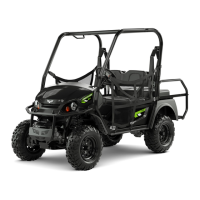MAINTENANCE
29
Battery Charging and Maintenance
Battery Safety
Always observe the following warnings when working on or near batteries.
To prevent battery explosion that could result in severe personal injury or death, keep all smoking materials, open
flames or sparks away from the batteries.
Hydrogen gas is formed when charging batteries. Do not charge batteries without adequate ventilation. A 4% concen-
tration of hydrogen gas is explosive.
Be sure that the key switch is off and all electrical accessories are turned off before starting work on the vehicle.
Never disconnect a circuit under load at a battery terminal.
Batteries are heavy. Use proper lifting techniques to move them. Always lift the battery with a commercially available
battery lifting device. Use care not to tip batteries when removing or installing them; spilled electrolyte can cause
burns and damage.
Electrolyte in a storage battery is an acid solution which can cause severe burns to skin and eyes. Treat all electro-
lyte spills to the body and eyes with extended flushing with clear water. Contact a physician immediately.
Always wear a safety shield or approved safety goggles when adding water or charging batteries.
Neutralize electrolyte spills with a solution of 1/4 cup (60 ml) sodium bicarbonate (baking soda) dissolved in 1-1/2 gal-
lons (6 liters) of water and flush with water.
Overfilling batteries may result in electrolyte being spilled from the battery during the charge cycle. Expelled electro-
lyte may cause damage to the vehicle and storage facility.
Aerosol containers of battery terminal protectant must be used with extreme care. Insulate metal container to prevent
can from contacting battery terminals which could result in an explosion.
Wrap wrenches with vinyl tape to prevent the possibility of a dropped wrench from shorting out a battery, which
could result in an explosion and severe personal injury or death.
Battery Disposal
Lead-acid batteries are recyclable. Return whole scrap batteries to distributor, manufacturer or lead smelter for recycling. For neutralized spills, place resi-
due in acid-resistant containers with absorbent material, sand or earth and dispose of in accordance with local, state and federal regulations for acid and
lead compounds. Contact local and/or state environmental officials regarding disposal information.
Battery
A battery is defined as two dissimilar metals immersed in an acid. If the acid is absent or if the metals are not dissimilar, a battery has not been created. The
batteries most commonly used in these vehicles are lead acid.
A battery does not store electricity, but is able to produce electricity as the result of a chemical reaction which releases stored chemical energy in the form of
electrical energy. The chemical reaction takes place faster in warm conditions and slower in cold conditions. Temperature is important when conducting tests
on a battery and test results must be corrected to compensate for temperature differences.
As a battery ages, it continues to perform adequately except that its capacity is diminished. Capacity describes the time that a battery can continue to pro-
vide its design amperes from a full charge.
A battery has a finite life, therefore good maintenance is designed to maximize the available life and reduce the factors that can reduce the life of the battery.
Battery Maintenance
The batteries can be accessed by raising and removing the seat bottom and battery cover.
At Each Charging Cycle
To reduce the possibility of fire, never attach a battery charger to a vehicle that is to be unattended beyond the nor-
mal charging cycle.
Before charging the batteries, inspect the plug of the battery charger and vehicle receptacle housing for dirt or debris.
Charge the batteries after each days use.
Monthly
• Inspect all wiring for fraying, loose terminations, corrosion or deterioration of insulation.
• Check that the electrolyte level is correct and add suitable water as required.
• Clean the batteries and wire terminations.
• Torque battery terminal nuts to 95 - 105 in. lbs. (11 - 12 Nm).
• Coat battery terminals with commercially available protectant.
• Replace all terminal covers.
TOOLS
• Insulated Wrench, 9/16” • Hydrometer
• Battery Carrier • Battery Maintenance Kit (P/N 25587G01)
• Battery Protective Spray

